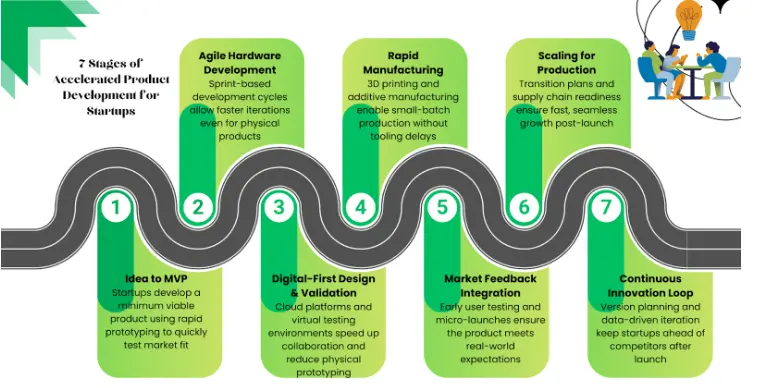Every startup founder knows the crushing pressure of racing against time while competitors breathe down their neck. In today’s hyper-competitive market, the difference between success and failure often comes down to who reaches customers first.
The companies that master faster product launches don’t just survive, they dominate their markets and leave slower competitors scrambling to catch up. When development cycles compress from months to weeks, startups can capture market opportunities before they disappear.
The Modern Startup’s Speed Imperative: Beyond Traditional Development Cycles
While speed-to-market has always mattered, today’s startup ecosystem demands a fundamental shift in how we think about development timelines. Let’s examine why traditional development cycles are no longer sufficient for competitive advantage in the modern marketplace.
Competitive Advantage Through Accelerated Time-to-Market
Market windows close faster than ever before, and 13 percent of businesses cite product mistiming as a primary reason for failure (https://blog.sellerant.com/strategic-planning-framework). This stark reality shows why timing isn’t just important—it’s everything.
First-mover advantages can define entire market segments. Companies that launch first often set industry standards, capture premium pricing, and build customer loyalty before competitors arrive. When startups integrate customer feedback in compressed timeframes, they create products that truly resonate.
Modern manufacturing technologies are revolutionizing how quickly startups can move from concept to market. By leveraging an hp 3d printer, development teams are able to enable rapid iteration cycles that compress traditional timelines by months. This technological acceleration allows teams to validate concepts quickly and move to production with confidence rather than guesswork.
Revenue generation acceleration becomes critical for cash flow management. Early market entry means faster revenue streams, which fuel further innovation and scaling efforts.
Cost-Efficiency Metrics of Rapid Development Approaches
Development cost reduction through iterative methodologies saves startups precious capital. Instead of building perfect products from day one, smart teams create minimum viable products that capture market feedback early.
Resource allocation optimization for lean teams means every dollar works harder. When development cycles shrink, teams can test more ideas with the same budget, increasing their chances of breakthrough success.
Understanding the strategic importance of accelerated timelines is just the foundation—the real transformation happens when startups implement cutting-edge prototyping methodologies. Discover how innovative prototyping techniques are revolutionizing the way successful startups bring products from concept to market.

Revolutionary Rapid Prototyping Techniques Transforming Startup Development
Today’s rapid prototyping techniques extend far beyond traditional methods, incorporating digital-first approaches that dramatically compress development timelines. Rapid prototyping with advanced additive manufacturing has become a core strategy for startups seeking to accelerate their path from concept to commercialization.
Advanced Digital Prototyping Ecosystems
Cloud-based collaborative design platforms enable distributed teams to work simultaneously on product development. Real-time stakeholder feedback integration systems ensure everyone stays aligned throughout the process.
Virtual testing environments reduce physical prototype needs, cutting costs and timeline requirements. Teams can simulate real-world conditions digitally before investing in physical builds.
Industrial 3D Printing Integration for Startup Innovation
Industrial 3d printing is now accessible to startups through service partnerships and leasing models, giving them the high-end capability to rapidly move from idea to functional prototype. Desktop versus industrial-grade systems offer different advantages depending on project requirements.
Multi-material printing capabilities enable complex product validation that wasn’t possible just years ago. Startups can now test functional prototypes that closely mirror final production quality.
Hybrid Prototyping Methodologies
Combining digital twins with physical testing creates comprehensive validation frameworks. Rapid iteration cycles using mixed-reality validation help teams understand user interactions before committing to expensive tooling.
These powerful prototyping tools are only as effective as the strategic framework that guides their implementation. Here’s how to structure your development process to maximize the impact of these revolutionary techniques.
Strategic Implementation Framework for Accelerated Product Development
Successful implementation requires structured approaches that balance speed with quality considerations.
Agile Development Architecture for Hardware Startups
Sprint-based physical product development cycles adapt software methodologies for hardware challenges. Cross-functional team coordination strategies ensure that design, engineering, and marketing teams stay synchronized.
Milestone-driven validation checkpoints prevent teams from pursuing the wrong direction for extended periods. Customer-centric companies are 60% more profitable than companies that aren’t, making validation crucial for success.
Supply Chain Acceleration Tactics
Pre-production supplier relationship building reduces delays when scaling begins. Component sourcing optimization for rapid scaling prevents bottlenecks that could slow market entry.
Manufacturing partner integration during the design phase ensures production readiness from the start. This approach eliminates costly redesigns that often occur when manufacturing considerations are considered too late.
While strategic frameworks provide the roadmap, advanced manufacturing technologies serve as the engine that powers rapid execution. Explore how next-generation additive manufacturing is becoming the secret weapon for startups seeking unprecedented development speed.
Advanced Additive Manufacturing Solutions for Competitive Edge
Additive manufacturing has moved far beyond just prototyping and is now being used for production-ready parts, fundamentally transforming how startups approach the design and manufacturing process.
Next-Generation Industrial 3D Printing Applications
Industrial 3d printing now enables production-ready part manufacturing, allowing startups to eliminate traditional tooling requirements for small batches. Quality assurance protocols for 3D printed components ensure reliability without sacrificing speed.
Cost-per-unit analysis for small batch production often favors additive approaches over traditional manufacturing for startup volumes.
Material Innovation Impact on Product Development Speed
Emerging materials for high-strength 3d printing mean that startups can produce functional parts faster, with less post-processing and greater performance. Biocompatible and specialized material applications open new market opportunities for innovative startups.
Sustainability considerations in rapid manufacturing align with growing market demands for environmentally conscious products.
Manufacturing capabilities represent just one piece of the acceleration puzzle—comprehensive technology integration amplifies these gains exponentially. Let’s dive into the digital ecosystem that transforms good ideas into market-ready products at lightning speed.
Technology Stack Optimization for Startup Growth Strategies
Startup growth strategies increasingly depend on sophisticated technology stacks that automate and accelerate development processes.
AI-Powered Design Acceleration Tools
Generative design algorithms create rapid concept development capabilities that human designers couldn’t match alone. Machine learning applications in product optimization reduce iteration cycles dramatically.
Automated testing protocols reduce manual validation time, freeing teams to focus on strategic decisions rather than repetitive tasks.
IoT Integration During the Development Phase
Real-time performance monitoring in prototype testing provides unprecedented insights into product behavior. Data-driven design iteration based on usage analytics ensures products meet actual user needs.
Connected product validation before market launch reduces post-launch surprises that could derail growth momentum.
Having the right technology stack accelerates development, but ensuring market fit requires equally rapid validation methodologies. Discover how successful startups compress traditional market research timelines from months into weeks.
Market Validation Acceleration Techniques
Rapid validation prevents costly mistakes while maintaining aggressive development timelines.
Rapid User Testing Methodologies
Micro-launch strategies for immediate market feedback provide real-world data faster than traditional research methods. A/B testing frameworks for physical products adapt digital marketing concepts for hardware applications.
Community-driven development approaches create early adopter networks that provide ongoing feedback throughout development cycles.
Pre-Launch Marketing Integration
Building anticipation during the development phase creates momentum for launch day. Influencer collaboration for early adoption generates buzz while products are still in development.
Crowdfunding serves as both a validation and a funding mechanism, proving market demand while raising capital for production scaling.
Rapid validation creates momentum, but sustaining accelerated development requires sophisticated financial strategies that go beyond traditional funding models. Here’s how smart startups engineer their finances to support aggressive launch timelines.
Financial Engineering for Faster Product Launches
Financial strategies must align with accelerated timelines to prevent cash flow issues that derail rapid development efforts.
Alternative Funding Strategies for Rapid Development
Revenue-based financing supports accelerated timelines without equity dilution. Strategic partnership funding models provide both capital and market access simultaneously.
Government grant optimization for innovation projects can provide non-dilutive funding specifically for rapid development initiatives.
Cost Management During Accelerated Development
Budget allocation for rapid iteration cycles requires different thinking than traditional development funding. ROI calculation for speed-to-market investments must account for competitive advantages gained through timing.
Risk management in compressed development timelines becomes critical when traditional safety nets don’t apply.
Securing funding for rapid development is crucial, but the real test comes in scaling efficiently after launch without losing the momentum that got you there. Learn how to transition from a startup sprint to a sustainable growth engine.
Scaling Strategies Post-Launch for Sustained Growth
Post-launch scaling requires careful planning to maintain rapid development capabilities while managing growth demands.
Automated Production Transition Planning
Seamless handoff from prototype to mass production prevents bottlenecks that could slow market momentum. Quality control system implementation ensures consistency as volumes increase.
Supply chain scaling preparation anticipates growth demands before they become constraints.
Continuous Innovation Pipeline Management
Parallel development track establishment maintains innovation momentum beyond initial product launch. Version 2.0 planning during the initial product launch ensures continuous market leadership.
Market expansion preparation strategies position companies for geographic or demographic growth opportunities.
Today’s scaling strategies are already being disrupted by tomorrow’s technologies, making it essential to understand what’s coming next. Explore the emerging trends that will define the next generation of ultra-fast product development.
Emerging Trends Revolutionizing Startup Product Development
Future technologies promise even faster development cycles and new competitive advantages for forward-thinking startups.
Quantum Computing Applications in Design Optimization
Complex simulation capabilities enable faster validation than traditional computing allows. Material science breakthroughs accelerate development by providing new possibilities for product design.
Blockchain Integration for Supply Chain Transparency
Traceability solutions reduce compliance delays that often slow product launches. Smart contract automation for supplier coordination eliminates manual processes that introduce delays.
These cutting-edge trends paint an exciting picture of the future, but implementing faster product launches today requires addressing the practical questions every startup faces. Let’s tackle the most common challenges and concerns about accelerated development.
The Path Forward for Startup Success
The companies that master rapid development cycles don’t just launch products faster, they create sustainable competitive advantages that compound over time. Success requires balancing cutting-edge prototyping technologies with strategic implementation frameworks that maintain quality while compressing timelines.
The startups that embrace these methodologies today will define tomorrow’s market leaders, turning speed into their most powerful competitive weapon while others struggle with outdated development approaches.
Common Questions About Rapid Product Development
Which rapid prototyping method delivers the fastest results for hardware startups?
Digital-first approaches typically offer the fastest initial validation, while hybrid methods combining digital and physical testing provide the most comprehensive results for complex products.
Can small startups compete with industrial 3d printing solutions typically used by large corporations?
Service bureau partnerships and equipment leasing make industrial-grade capabilities accessible to startups without massive capital investments or long-term commitments.
What are the biggest mistakes startups make when trying to accelerate product launches?
The most common pitfall is sacrificing user validation for speed, leading to products that launch quickly but fail to gain market traction.
Also Read-Boost Your Business Visibility with Mobile Advertising








